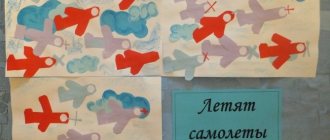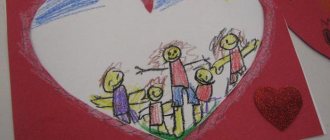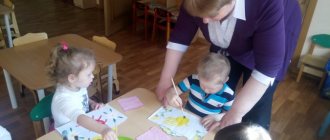Drawing a hedgehog using an unconventional technique; methodological development for drawing (junior group)
METHODOLOGICAL DEVELOPMENT
“DRAWING A HEDGEHOG IN A NON-TRADITIONAL TECHNIQUE”
Topic: “In the forest”
Topic for the program “Drawing a hedgehog in an unconventional technique”
Group 2 junior
Purpose of the lesson: To develop the ability to draw using non-traditional techniques
Tasks in the integration of educational areas:
NGO "Cognitive Development":
– introduce students to the life of wild animals;
– develop cognitive interest.
NGO "Artistic and Aesthetic Development":
– introduce the method of working with an unconventional technique using a foam rubber swab;
– develop the ability to create simple plot compositions;
– develop interest in creativity and imagination;
– develop the ability to draw lines rhythmically and accurately.
NGO "Speech Development":
– develop vocabulary;
– develop the ability to competently answer questions posed.
NGO "Physical Development":
– develop fine motor skills.
NGO “Social and communicative development”:
– cultivate hard work;
– develop the ability to interact with adults and peers.
Equipment: gouache paints, foam swabs, sippy cup, creative napkin, paper napkins, A-5 album sheets, board, hedgehog toy, pictures of a hedgehog on a magnetic board.
Type of lesson: repetition of covered material, formation of new skills.
List of references: Program “From birth to school” edited by N.V. Veraksa, T.S. Komarova, M.A. Vasilyeva;
“Drawing with children 3-4 years old” by D.N. Koldin;
A.V.Nikitina “Non-traditional drawing techniques in preschool educational institutions. A manual for educators and parents";
Kazakova R. G. “Drawing with preschool children” (non-traditional techniques)
| № | Lesson stages | Stage organization, equipment | Main content of the stage Activities of a teacher | Children's activities | Provisions for children with special educational needs |
| 1 | Organizational moment (2 minutes) | Napkins for creativity, foam swabs, paints, a glass of water, sheets of A-5 format, a toy hedgehog, pictures of hedgehogs, clothespins, a hedgehog stencil | (Teacher) “Children! Let's go with you today to the autumn forest. Let's stomp our feet and clap our hands! We walk through the group to the carpet, stop, and sit on the mat. We found ourselves in an autumn meadow! Oh! Someone is rustling! (rustle the newspaper) What is that rustling noise? Yes, it's a hedgehog! (show the toy hedgehog). A poem about a hedgehog: The hedgehog is a gray ball. He came running, his legs are not visible. Take away the needles, Prickly, like a Christmas tree And, like grandpa, a burdock! Let me stroke it, quickly. I got scared, puffed. I wanted to play... | Children listen to the teacher They stomp and clap Children listen and watch. | The teacher checks the availability of all necessary items for the lesson. |
| 2 | Main part (8 minutes total) of which: (5 minutes)- (1 minute)- (3 minutes)- | Hedgehog toy | -"Hello guys! (the teacher speaks on behalf of the hedgehog). Do you recognize me? Who am I? Where I live? (the hedgehog recites a verse: “Why are you, HEDGEHOG, so prickly?” “This is me, just in case: Do you know who my neighbors are? Foxes, wolves and bears!” Then the hedgehog says : - “Do you see how many needles I have? How not?? Where did I lose them??? Now all the animals can hurt me! Guys! Help me please!" (teacher) “Children! Let's help the hedgehog! Look! I found 1 needle, look around you - have you found more? Attach needles to the hedgehog. That's how great it is!! Hedgehog: “Thank you guys! Now no one is afraid of me! It's time for me to go home! Goodbye!" (teacher) - It’s time for us to return to kindergarten. Physical education minute. - Stomp with your right foot, Stomp with your left foot, Again with your right foot, Again with your left foot. Then with your right foot, After with your left foot. And then you’ll come home. Practical work Work algorithm (painting using a foam pad) (teacher) “Well, we’re back in kindergarten, sit down in your seats. Did you like it? Look! In front of you on the tables lies a hedgehog (a sheet of A-5 paper, with a hedgehog outlined in a stencil), but it also has no needles! Take a foam swab, dip it lightly in water and then in paint and draw needles on it. (verbal explanation accompanied by demonstration) | Children's answers The children answer in unison: “No! You don’t have needles!!!” The children look around them, find more clothespins and attach them to the cardboard back of the hedgehog. Perform leg movements. Children watch carefully and repeat after the teacher. Applying needle strokes to the image of a hedgehog | They answer by looking at their comrades (other children). Listens. Looks for clothespins with the help of the teacher. Performs movements with the help of the teacher and repeating after other children. Listens, looks. With the help of the teacher, he applies strokes with a foam swab. |
| 3 | Summary of the lesson. Reflection (5 minutes) | Now, take your works and place them on the windowsill, and when they are dry, we will put them in your cabinet pockets and make an exhibition! Did you like working with foam swabs? It was an unconventional painting technique. You are all great guys!!!!!! Exhibition in pockets | They listen, take their work to the windowsill, look at it, discuss the work of other children. Washing hands | Shows the drawing you like the most. |
Theme of the week: “Autumn trees and bushes”
Lesson 6. Autumn leaf fall
(Painting with a brush using the “dipping” method. Gouache)
Target. Teach children to paint with a brush using the “dipping” method, changing the color of the paint; strengthen the ability to hold a brush correctly, pick up paint on the bristles, and rinse the brush. Learn to distinguish and name colors. Develop speech and thinking.
Demonstration material. Basket, multi-colored tree leaves cut out of cardboard (yellow, green, red, orange).
Handout. A landscape sheet on which a tree is drawn, gouache, a brush, a jar of water.
Progress of the lesson
Start your lesson with a physical education session.
Read the poem to the children and ask them to perform the appropriate movements:
The wind blows in our faces
The tree swayed.
The wind is quieter, quieter, quieter,
The tree is getting higher and higher.
On the first two lines of the poem, children raise their arms and swing their bodies in different directions, on the third line they quietly squat, and on the last line they slowly stand up.
Ask the guys: “What falls from the trees in the fall?” (Leaves.)
Scatter colorful leaves cut out of cardboard on the floor and invite the children to collect only yellow leaves in a basket, then green, red, orange. Leaves can also be collected into four boxes of matching colors. Then place a landscape sheet with a tree on it in front of each child and ask them to draw falling leaves. Remember to hold the brush with your thumb and middle finger, holding it on top with your index finger, not too close to the sharpened end.
Show the children how to draw paint onto the pile and apply it sideways to the sheet. First, you can practice the guys in the technique of “dipping” with a dry brush.
Encourage little ones to spread the leaves all over the leaf. Remind that in order to change the color, you need to thoroughly rinse the brush in water and pick up another paint.
Theme of the week: “Autumn”
Lesson 7. Autumn rain
(Drawing with colored pencils)
Target. Teach children to draw short lines with colored pencils, conveying falling raindrops; strengthen the ability to hold a pencil correctly. Learn to analyze and understand the content of a poem.
Demonstration material. Toy hare.
Handout. A landscape sheet on which clouds are drawn or glued and a picture of a hare sitting on a bench, colored pencils.
Progress of the lesson
Show the children a toy hare and read A. Barto’s poem “Bunny”:
The owner abandoned the bunny,
A bunny was left in the rain.
I couldn't get off the bench,
I was completely wet.
Ask the guys: “Who did the mistress leave? (To the bunny.) Where is the bunny? (In the rain.) Why did the bunny get wet? (I couldn’t get off the bench.) What kind of bunny?” (Wet, sad, long-eared, frozen.)
Invite the kids to draw rain. Place in front of each child a landscape sheet with clouds drawn or pasted on it and a picture of a bunny sitting on a bench. Remind children how to hold a pencil correctly and draw short strokes with it, freely placing them over the entire surface of the sheet.
Theme of the week: “In the forest”
Lesson 8. Hedgehog
(Drawing with a foam swab. Gouache)
Target. Teach children to draw lines with a foam pad. Develop fine motor skills of the hands.
Demonstration material. A silhouette of a hedgehog cut out of cardboard, clothespins, a crumpled sheet of paper or newspaper.
Handout. A landscape sheet with a hedgehog drawn on it, gouache, a foam swab, and a glue stick.
Progress of the lesson
Invite the children to go for a walk in the forest: “Let's go to the forest. Stand one after another and walk along the path. Do you hear? Someone is rustling! (Subtlely rustle the crumpled newspaper.) Who is it? Hedgehog! (Show the children a hedgehog cut out of cardboard). Say hello to the hedgehog."
Invite the kids to tell the hedgehog a poem:
We walked slowly through the forest,
Suddenly we saw a hedgehog.
Hedgehog, hedgehog, we are friends,
Let us pet you.
Pet the hedgehog with your children and draw their attention to the fact that it is somehow strange - not prickly.
Hedgehog . For some reason I don’t have thorns, and all the animals in the forest offend me. Please make me some thorns.
Let the kids attach clothespins along the edge of the hedgehog's back on their own.
Tell the children: “Now you need to draw needles for the hedgehog.” Place a landscape sheet with a picture of a hedgehog in front of each child and ask them to draw needles. Children should draw lines on the back of the hedgehog first with dry foam rubber, and then with foam rubber soaked in paint.
At the end of the lesson, the hedgehog thanks the children: “Thank you, guys. Now I have needles and I’m not afraid of either the evil wolf or the fox.” Invite the children to draw a path along which the hedgehog will go home to the forest.



